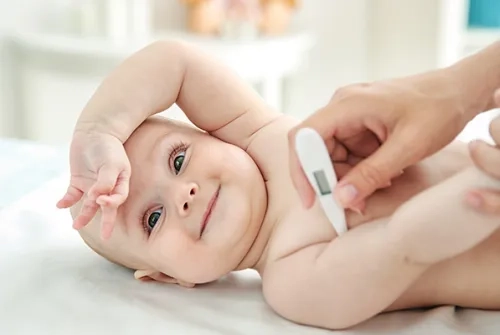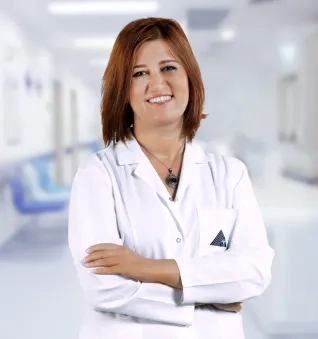Alo Yeditepe
Alo Yeditepe
High Fever in Children Article Series I
Do Not Forget to Give Water to a Child with a Fever
Dehydration of the body during high fever gets the fever out of control and causes the infection to progress faster. For this reason, do not forget to give the child with a fever plenty of water and fluids. Yeditepe University Kozyatağı Hospital Pediatric Health and Diseases and Pediatric Allergy and Immunology Specialist Prof. Dr. Hülya Ercan Sarıçoban explains what are the points to be considered when approaching a child with fever.
What Does a Fever in Children Mean?
We call a body temperature (38.3 degrees) above normal limits a fever. The environment being too hot or dressing the child in thick clothes may cause a fever. However, if the fever does not decrease when the temperature is lowered or the child's clothing is lightened, it may be due to an infection or another illness. If the fever is resistant if it rises again after dropping 4-6 hours ago if there is vomiting, headache, diarrhea, cough, shortness of breath, swelling in the joints, and loss of consciousness, parents should take the child to the hospital urgently.
What Symptoms Accompany Fever?
It depends on the type of infection. Diarrhea, vomiting, and nausea can be seen in gastrointestinal system problems. If the child has pneumonia or bronchiolitis, cough, and expectoration may accompany. A sore throat may occur in throat infection, while nausea, headache, vomiting, and seizures may occur in meningitis. Of course, infections are not the only cause of fever. Fever can also be seen in rheumatic diseases, cancers, and poisonings. In rheumatism, symptoms such as joint swelling, rashes on the body, and abdominal pain may occur. Sometimes it is not clear why the fever rises. This is a fever of unknown origin and needs to be investigated in detail.
What to Do When a Fever Occurs?
First, take the child to a cool place. If his/her clothes are thick, take them off and put on thin clothes. Do not put blankets or quilts on him/her, even if there is trembling. Depending on the height of the fever, if necessary, he/she can even stay with only underwear. Make him/her take a warm shower or cool his/her face, arms, legs, and torso with a wet cloth. Make him/her drink plenty of water and fluids. Give an age-appropriate antipyretic recommended by the physician. Physicians most often use paracetamol and ibuprofen group medications for this purpose.
How to Prevent Water Loss During Fever?
Dehydration (water loss) is very dangerous, even on its own it can cause the patient to enter into shock. Therefore, it is necessary to prevent children from becoming dehydrated during a fever. Especially babies cannot easily maintain the fluid balance in the body. With fever, their breathing may accelerate, and water vapor loss may occur from respiration and the skin. As the fluid in the body decreases, the fever rises. The younger the child or the later the intervention against fever, the more often dehydration occurs. 70% of our body is made up of water, and as the water ratio decreases, the healthy functioning of all cells and organs is impaired. In this case, the fever may get out of control, the infection may progress faster, and if the fever is very high, seizures may occur, especially in children under the age of 5.
Are Special Precautions Necessary in Allergic Children?
If an allergic child has a fever, the cause is not the allergy alone, but the infection. If the allergic disease is not treated well, for example, if the nose of the child with allergic rhinitis is not cleaned well, this can lead to ear inflammation or sinusitis after a while. Again, if the sputum in the bronchi cannot be controlled, it may cause pneumonia. In such cases, fever may occur.
Beware of Drug Allergies!
Allergic children may be allergic to antipyretics. Antipyretic drugs used may have undesirable side effects. In this case, it would be beneficial to consult an allergist for a treatment plan. In addition to all these, sometimes itchy and red rashes called hives or urticaria may occur with fever in the body. These can be seen with the infection, but if they are above normal, a specialist should be consulted.
Press Coverage: posta
About
Faculty and Year of Graduation:
Hacettepe University Faculty of Medicine, 2000
”
See Also
- Is Swallowing Cat Hair Dangerous?
- What is Predisposition to Allergy (Atopy)?
- Allergies in Children Can Increase During the Summer Months
- How to Choose Baby Clothes?
- If Your Child is Constantly Getting Sick in the Winter, It Could be Due to Allergies
- Vaccine Rejection Can Lead to Irreversible Problems!
- Children Whose Parents Are Allergic Are More At Risk
- Pay Attention to the Children Who Get Sick Often
- Allergic Disease Rates Increased from 3% to 15% in the Last 20 Years
- Genetics is the Key Cause of Food Allergies in Children
- Pay Attention to Food Allergies in Children!
- Points to Be Considered in Baby Clothing
- What and How Much Should Children Eat at Which Time of Meal?
- What is the Right Lunch Box for Children?
- Infection Can Cause the Onset of Asthma Disease
Alo Yeditepe




